The previous weekend, Freiburg welcomed Eintracht Frankfurt in a battle between two sides that are involved in the group of contenders for the European spots. In the end, the home side could win the match 1-0 and therewith consolidate their position within the Bundesliga top group.
In the following tactical analysis, we are going to explain how both sides neutralised each other with similar tactics in the first half. Moreover, our analysis will examine Freiburg’s win-bringing attacking strategy with one man up in the second half and will answer the question of why they were still lucky with these three points.
Lineups and formations
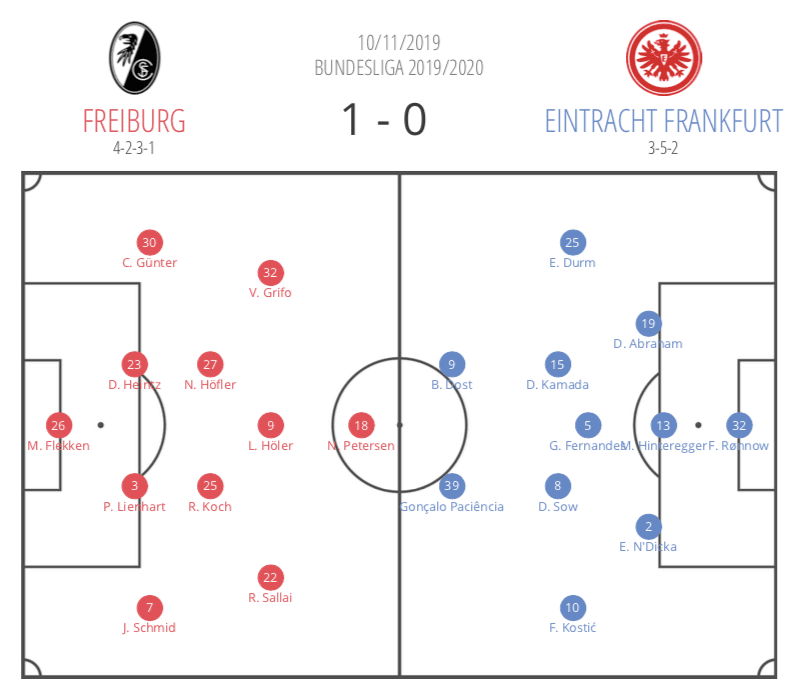
Freiburg coach Christian Streich lined his side up in a 4-2-3-1 formation. However, his side often set up differently as central midfielder Robin Koch played a hybrid role acting partly as a central midfielder (out of possession) and partly as a central defender (in possession). In the attack, striker Nils Peterson acted as the most offensive player whereas Lucas Höler positioned himself just slightly behind him. Their wide attackers in Vincenzo Grifo and Roland Sallai while both full-backs moved high up the pitch
As the graphic below shows, Nicolas Höfler was left alone in central midfield which also caused some issues for Freiburg as we will explain at a later stage of our analysis. Furthermore, the high positioning of Freiburg’s attacking department was caused by their attacking approach in the second half.
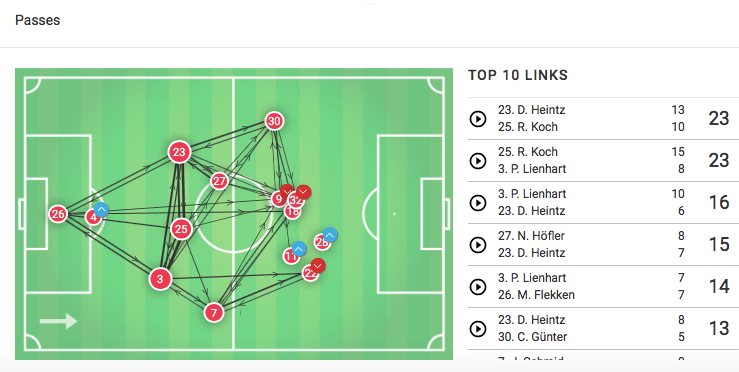
Eintracht Frankfurt, on the other hand, nominally played with three central defenders. Frankfurt coach Adi Hütter chose to line up a striking duo in Bas Dost and Gonçalo Paciência upfront. Their central midfielders, mostly acted in central areas while single-pivot Gelson Fernandes played closer to the back three than the two advanced midfielders. Therewith Fernandes was supposed to stop Freiburg’s counter-attacks.
Frankfurt’s attacking phase was mainly focused on their left side which is why left wing-back Filip Kostić played a higher role than right wing-back Erik Durm as can be seen in the graphic below.
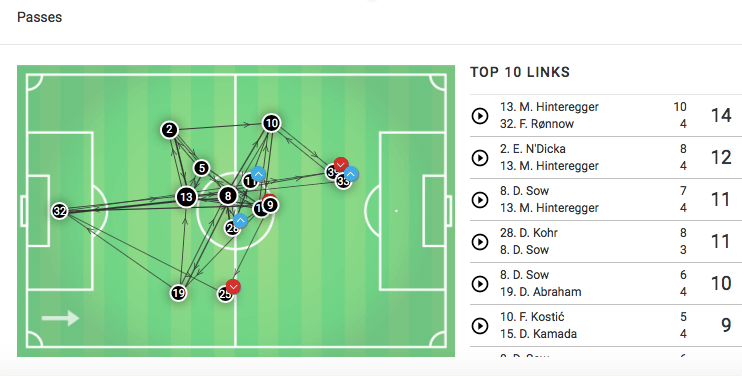
Man-oriented pressing approaches
In the first half, both sides used similar approaches in terms of their build-up and press. Both teams used a man-oriented pressing approach. And, in addition to that, Freiburg and Frankfurt were both versatile in terms of their build-up structure switched between a line of four and a line of three when building up.
Frankfurt rarely succeeded to cleanly progress up the pitch due to Freiburg’s well-organised press. Hütter’s team either built up their play with their back three or, more often, created a back four with left wing-back Kostic high up the line allowing left centre-back Evan N’Dicka to move wide. Freiburg striker Petersen then pressed the central player of Frankfurt’s back three in Martin Hinteregger while still keeping single-pivot Fernandes in his cover-shadow.
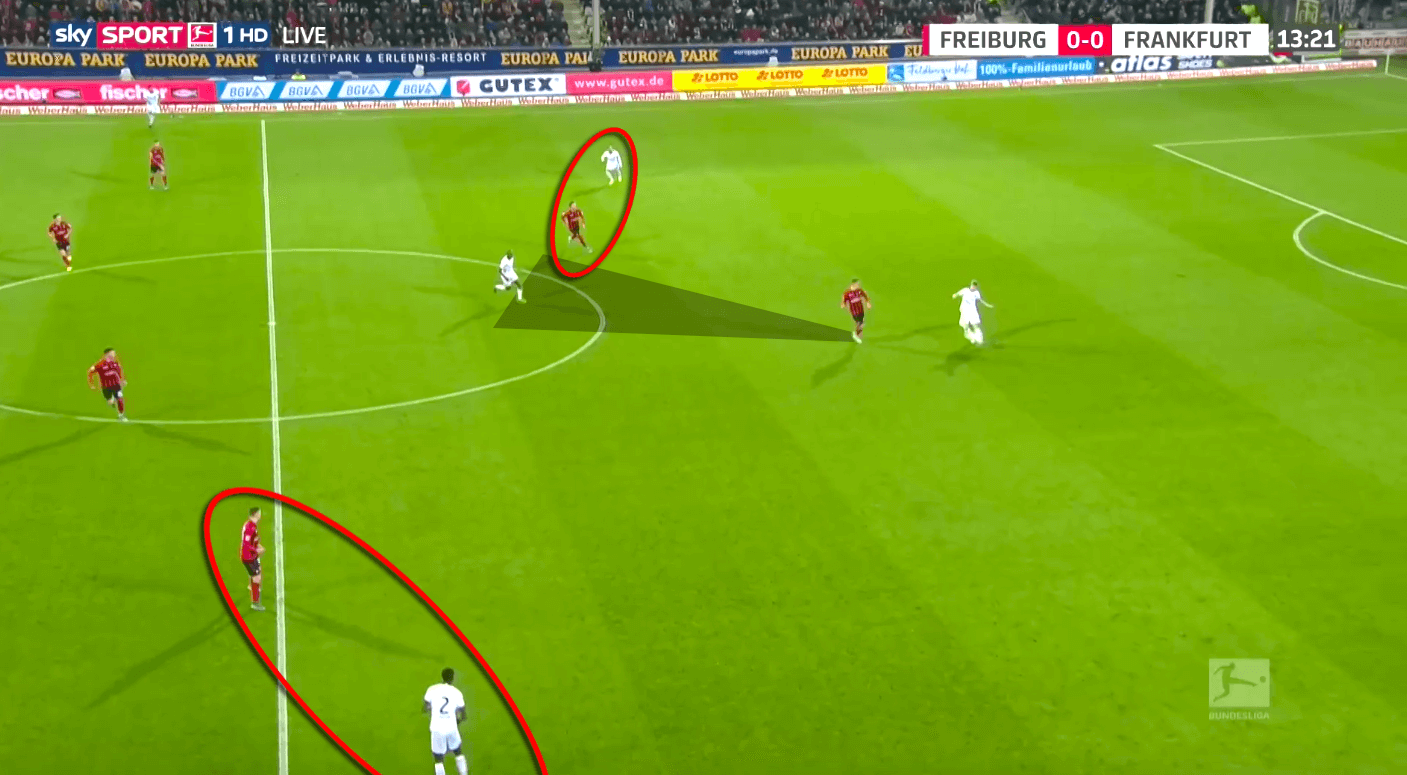
At the meantime, Freiburg’s right forward Sallai marked the opposition left-back to prevent a simple pass onto the wing. Höler, lined up behind Petersen, moved up to mark the right central defender of Frankfurt in these cases as shown in the image above. As a result, Frankfurt either had to play long balls towards their striking duo or play the ball down the half-space. To do this, however, they needed to find a spare man in midfield. That was difficult though, as Freiburg’s man-orientations in midfield prevented the opposition midfielders from receiving and turning.
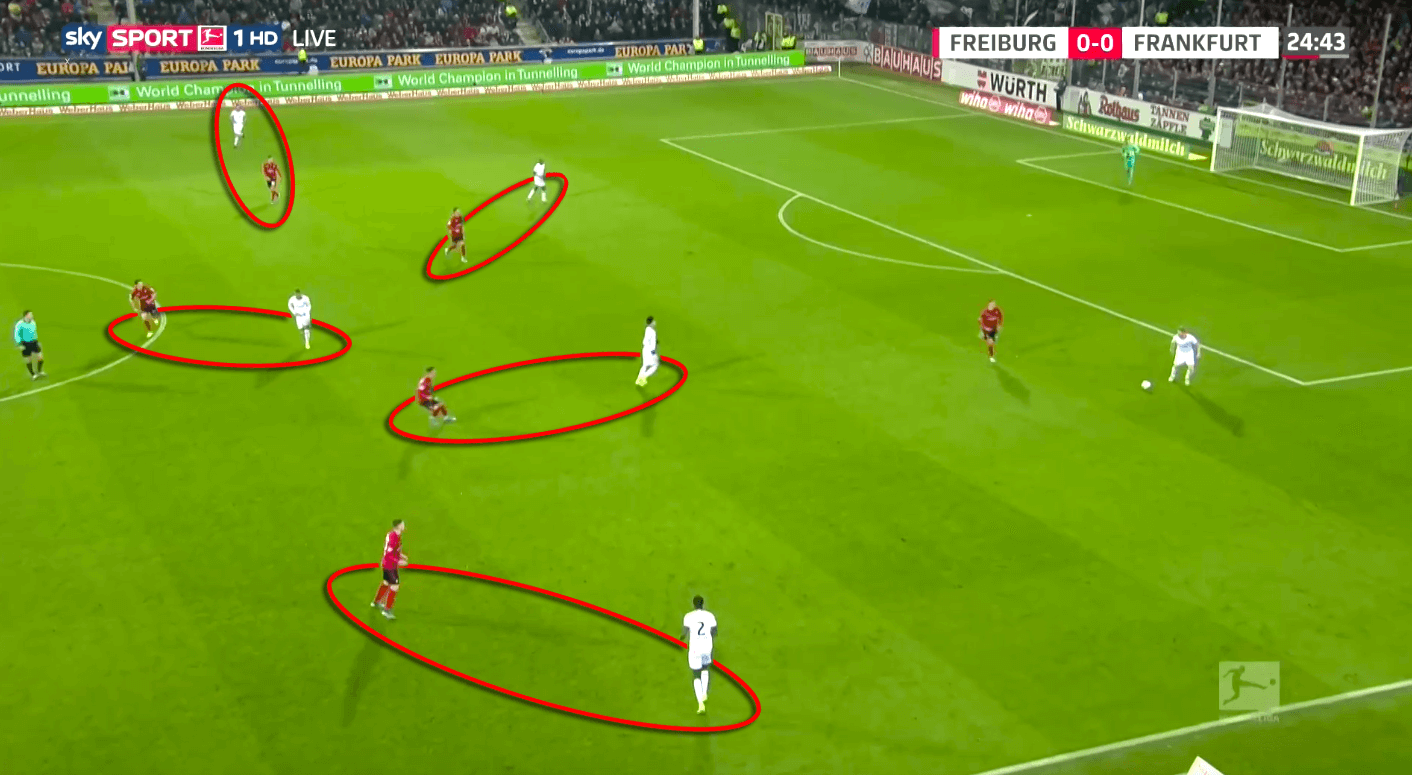
Frankfurt found one rare way of breaking lines which is displayed in the next image. Central defender Hinteregger utilised the fact that Freiburg’s midfielders were too focused on their direct opponents and carried the ball up the pitch himself.
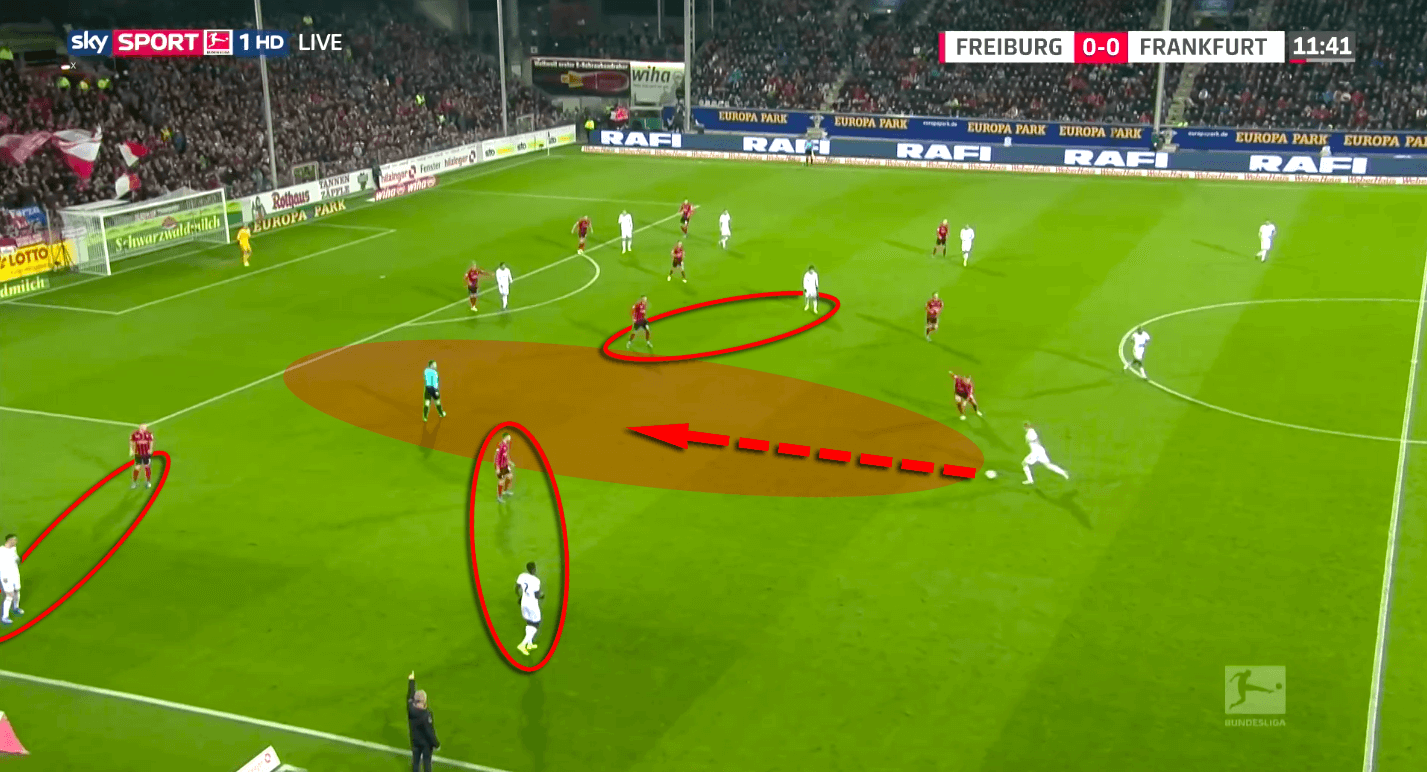
Nevertheless, Frankfurt’s attackers had not taken up positions to receive the ball in these cases so that the Austrian defender had to finish the attack – without luck.
Freiburg, on the other hand, played with a nominal back four which often turned into a back three during the build-up. But Frankfurt also pressed in a man-oriented way like in the image below. Often Freiburg attempted to take advantage of their goalkeeper in the build-up. However, imprecise passes often forced Freiburg to play a long ball in the end as well.
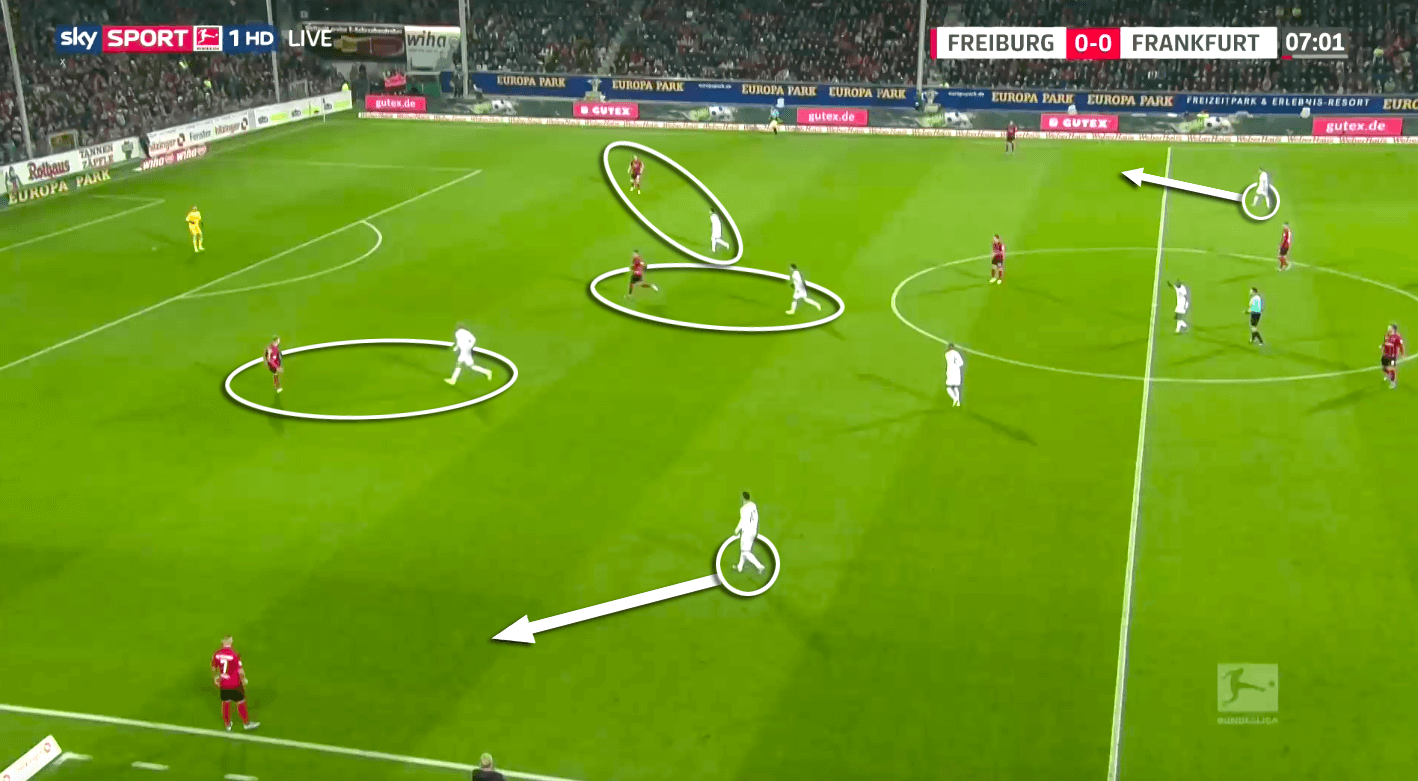
The well organised pressing systems as well as the fact that both sides did not risk too much in the build-up phase and rather searched for their attackers with long balls, led to a first-half with only a few chances.
Freiburg’s crosses against Frankfurt’s deep block
Just before half-time, Frankfurt’s defensive midfielder Fernandes was sent off with his second yellow card for stopping a Freiburg attack with a foul. As a consequence, Hütter’s side were one man down for half of the match.
Playing with ten men, Frankfurt set up in a low-block within the second half of the game. Hütter’s side utilised a 5-3-1 shape to guide Freiburg’s attacks onto the wings.
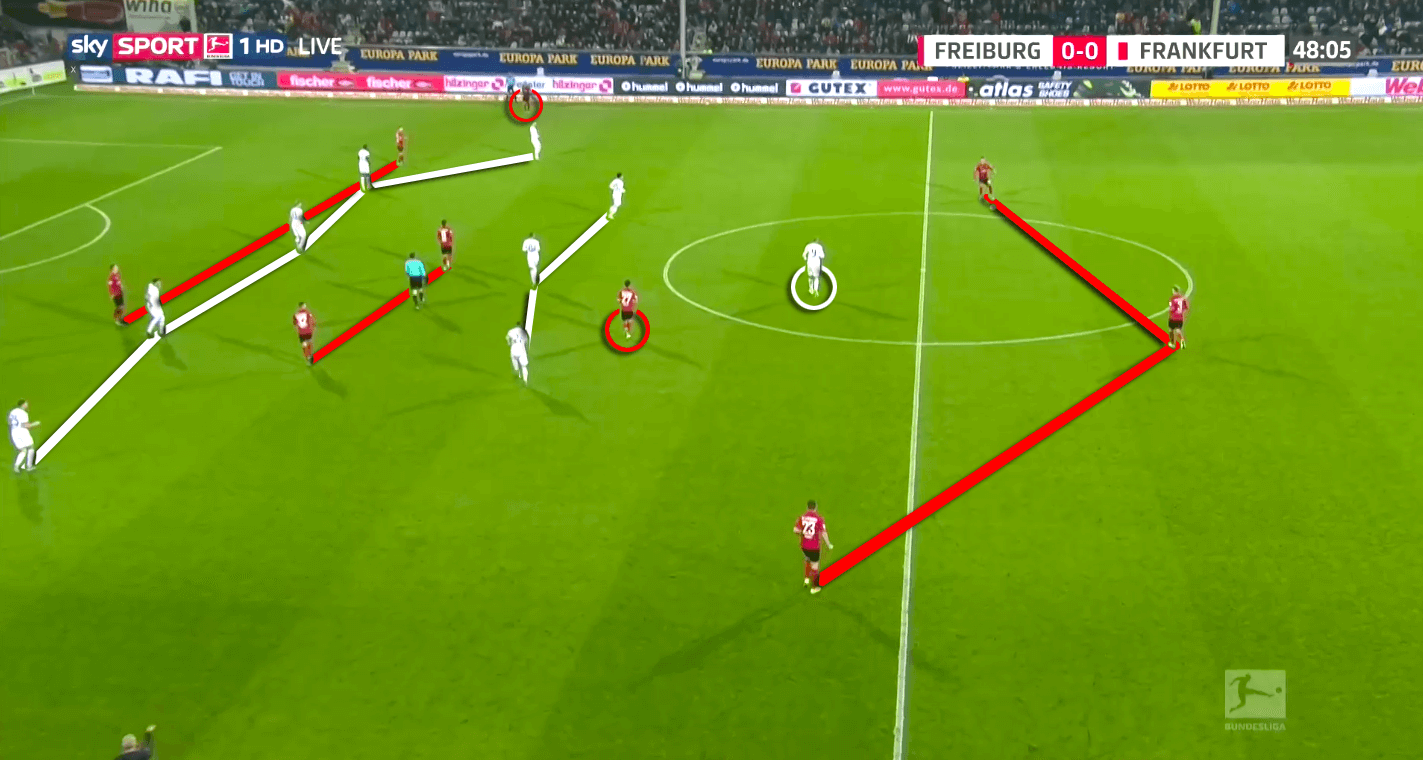
In order to break this block, Freiburg’s attackers pushed high up the pitch leaving central midfielder Höfler alone in midfield. Their attackers occasionally dropped into areas between the lines like in the image above. But the vertical compactness of Frankfurt’s block disabled Freiburg to break through in central areas.
Due to the high positioning of Freiburg’s attackers, they often had the opportunity to create chances from crosses though. Often several of their attackers positioned at the far post and therewith overloaded Frankfurt’s ball far central defender.
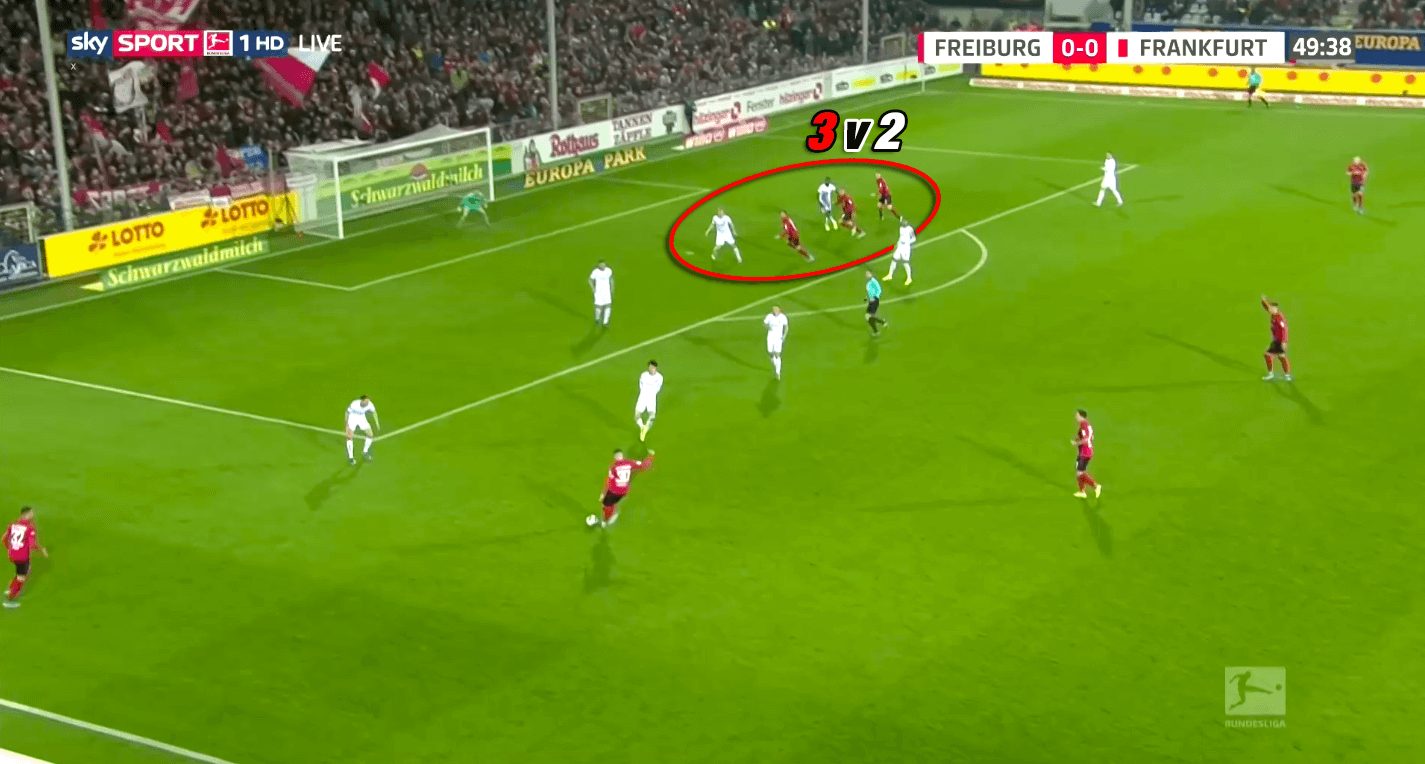
As Freiburg mostly attacked down the left flank, left centre-back N’Dicka was confronted with Freiburg’s attackers at the far post. Since left wing-back Kostić and the central midfielders missed to support N’Dicka, the French defender was over-challenged with the number of direct opponents only being supported by central defender Hinteregger.
That issue became even severe when Frankfurt substituted attacking midfielder Mijat Gaćinović who replaced central midfielder Daichi Kamada. Gaćinović tended to defend next to striker Dost, Frankfurt’s shape then resembled of a 5-2-2.
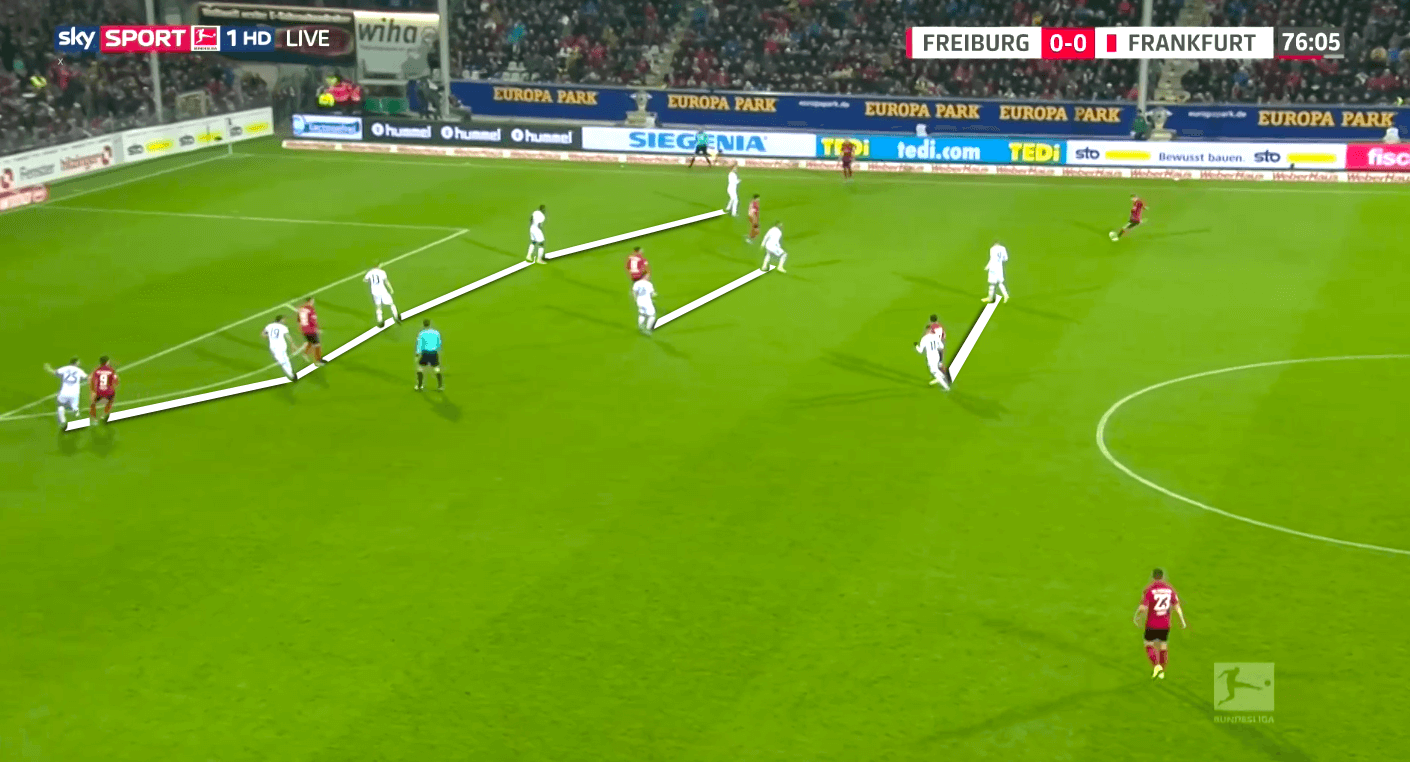
As this obviously did not provide much width within the midfield, Frankfurt were vulnerable after switches of play as they lacked a midfielder to close the half-space or support the wing-back. As a consequence, Streich’s team put in a cross and score at the second post by taking advantage of the aforementioned concept.
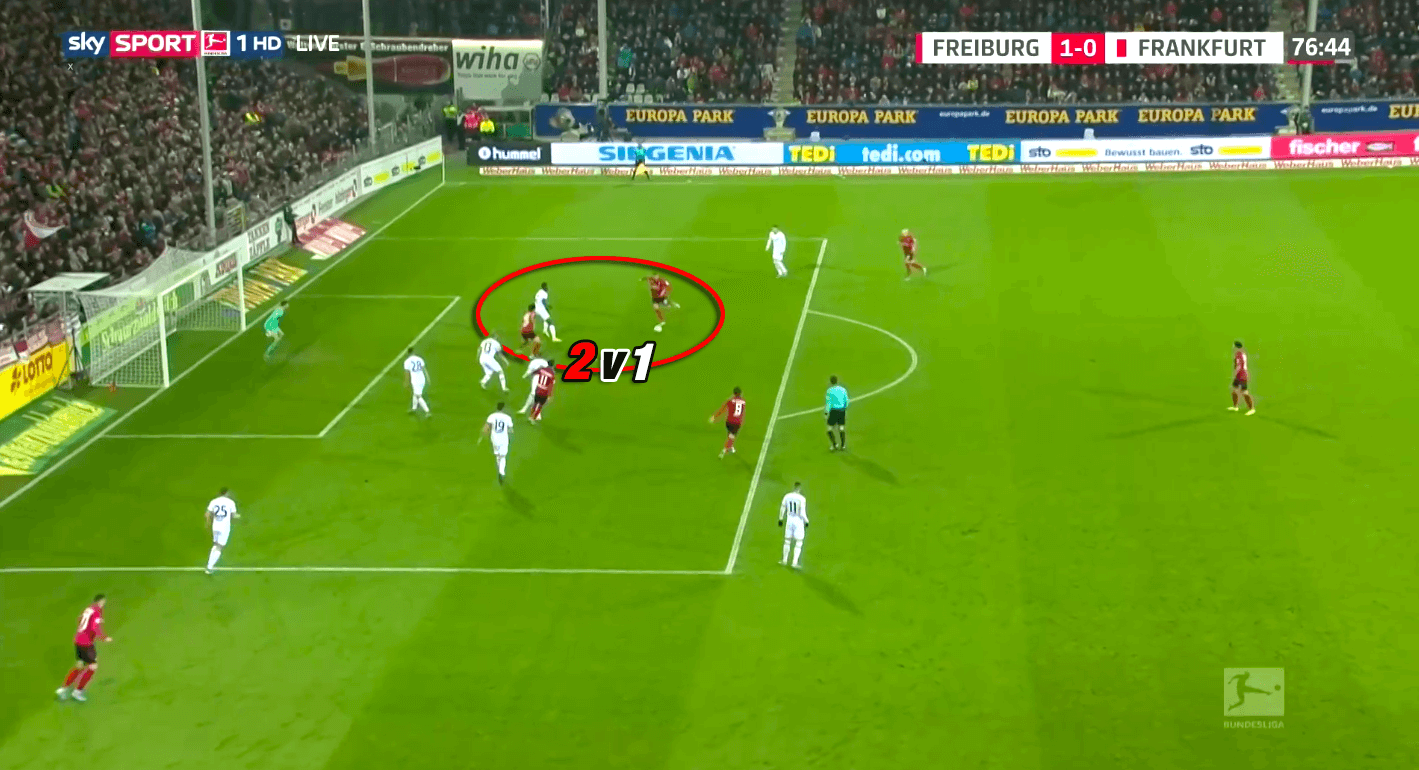
Frankfurt‘s direct attacking approach in the final phase
Throughout the whole game, Eintracht Frankfurt were capable of creating promising opportunities on the break. Most of these attacks were facilitated by Freiburg’s insufficient occupation of central midfield. Since Freiburg’s attackers were positioned very high in order to provide depth to break Frankfurt’s block, there was offered huge space in midfield for Frankfurt. Hütter’s side used this space to counter-attack through the centre, as displayed below, in contrast to their usual focus on attacking through the wings.
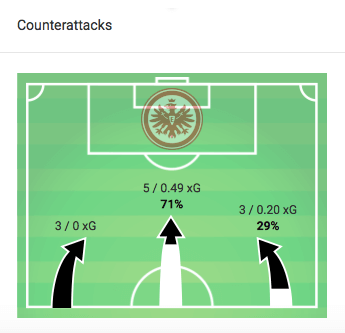
Freiburg midfielder Koch who was supposed to be part of a double pivot with Höfler often defended behind his partner. That was because he acted between the two central defenders in possession. But it allowed Frankfurt enough space to outnumber Höfler like below and progress further up the pitch.
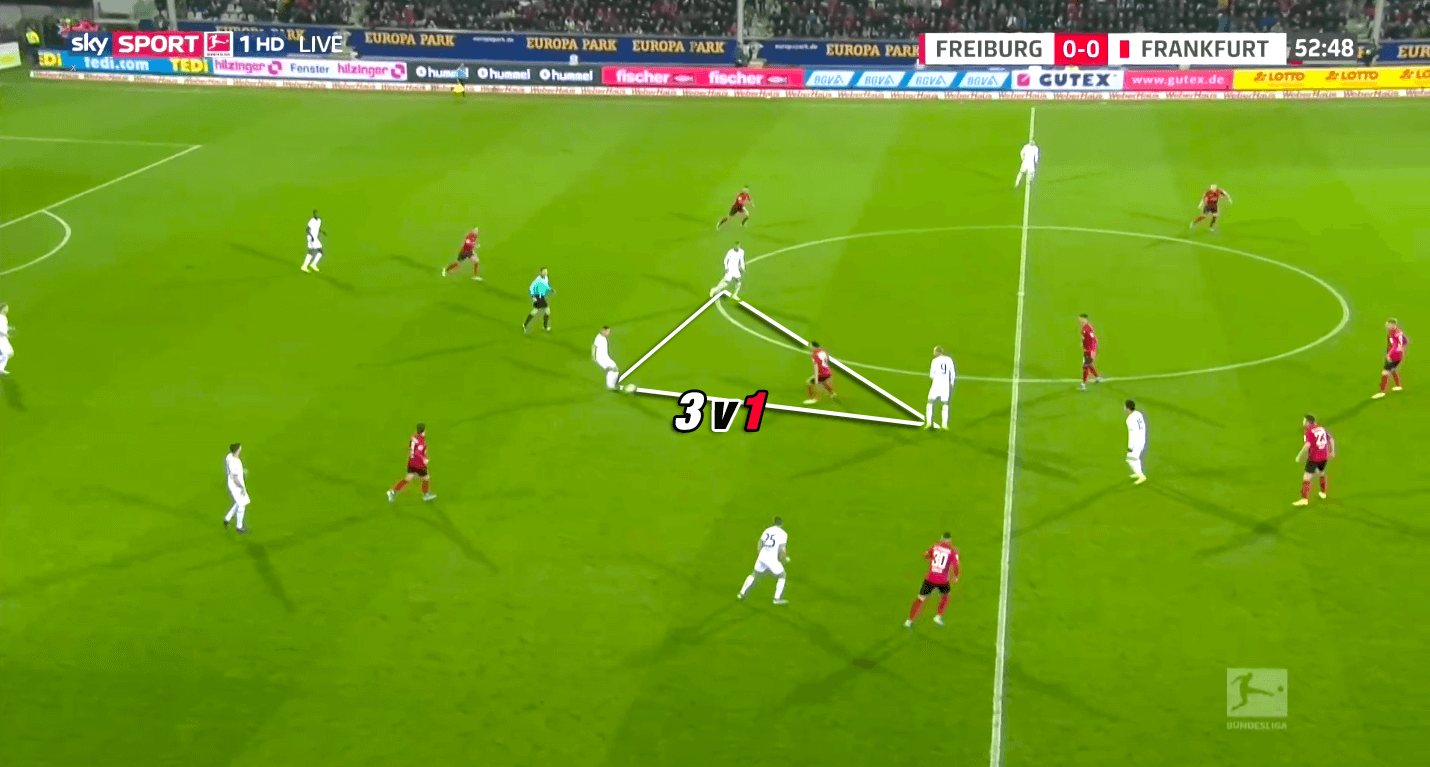
In the final stage of the game, Frankfurt could create some more opportunities which is why Freiburg were lucky with this win. Especially with long balls, Frankfurt could utilise their superiority in midfield.
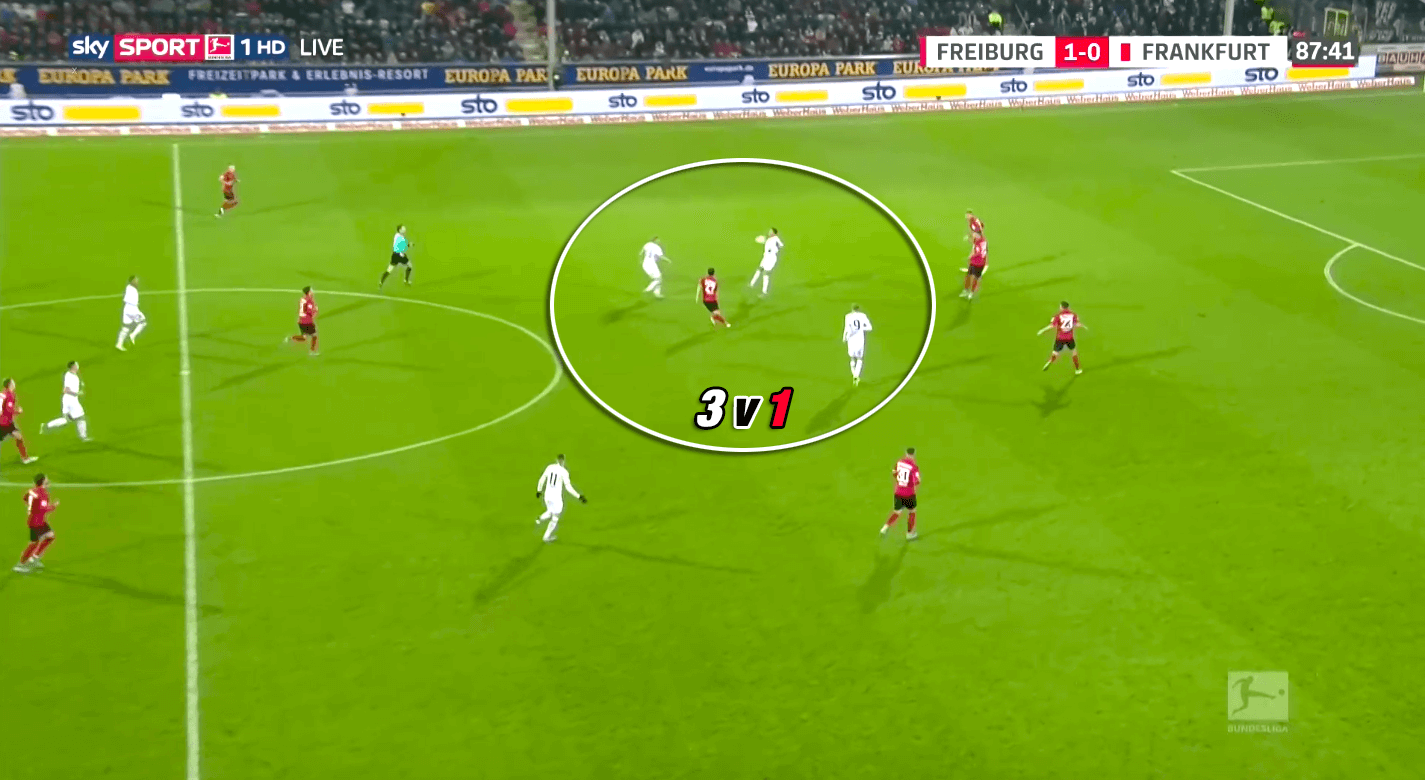
This superiority was caused as Freiburg’s defenders often dropped and did not move out to press Frankfurt players between the lines.
With a sequence of and threatening set-pieces, Frankfurt nearly scored the late equaliser.
Conclusion
As shown in our analysis, it was a tight match between two teams with similar tactics. Due to the well-organised press and the risk-minimised attacking strategies in the form of long balls, it was not a big surprise that the game did not offer many chances.
In the end, Freiburg benefited from the fact that they played with one more man throughout the whole second half. Freiburg’s cross concept allowed them to score the only goal of the game while their defensive issues were not penalised as Frankfurt failed to convert their chances.

If you love tactical analysis, then you’ll love the digital magazines from totalfootballanalysis.com – a guaranteed 100+ pages of pure tactical analysis covering topics from the Premier League, Serie A, La Liga, Bundesliga and many, many more. Buy your copy of the November issue for just ₤4.99 here





Comments